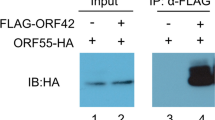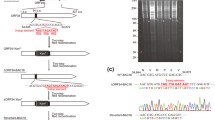Summary.
The ART (Activator of Replication and Transcription) protein of Kaposi’s sarcoma-associated herpesvirus (KSHV), or human herpesvirus-8 (HHV-8), is encoded by the ORF50 gene. It is expressed as an immediate-early gene and plays a crucial role in the transition between latency and productive infection. HHV-8 ART is a transcriptional transactivator which can up-regulate viral gene expression. Transient expression assays showed that ART strongly activated ORF57 and K8 promoter-directed gene expression in both CV-1 and BJAB cells. The ART target site was mapped to a 40-bp region compassing nt 81904 to 81943 on the ORF57 promoter. When linked upstream to a heterologous SV40 promoter, this region by itself was able to confer ART responsiveness. This 40-bp segment contains a 16-bp consensus sequence which is also found in the K8 promoter region located between nt 74769 to 74784. Deletion of the fragment including this 16-bp consensus abrogated the ART responsiveness of the K8 promoter. The role of this 16-bp consensus in ART transactivation was further supported by site-directed mutagenesis. Mutations of the conserved nucleotides within the 16-bp consensus in the ORF57 promoter dramatically impaired its responsiveness to ART. Fusion protein analysis with chimeric proteins containing the DNA binding domain of yeast transactivator Gal4 (residues 1 to 147) and different ART segments defined an acidic C-terminal region (amino acids [aa] 527 to 634) as a potent activator. Deletions of this activation domain in the ART protein resulted in a decrease or loss of its ability to activate ORF57 and K8 promoters containing the ART responsive element in transfected cells. How the ART activation domain activates ORF57 and K8 gene expression through the 16-bp consensus sequence remains to be determined.
Similar content being viewed by others
Author information
Authors and Affiliations
Additional information
Received August 30, 2000 Accepted November 29, 2000
Rights and permissions
About this article
Cite this article
Wang, S., Liu, S., Wu, M. et al. Kaposi’s sarcoma-associated herpesvirus/human herpesvirus-8 ORF50 gene product contains a potent C-terminal activation domain which activates gene expression via a specific target sequence. Arch. Virol. 146, 1415–1426 (2001). https://doi.org/10.1007/s007050170102
Issue Date:
DOI: https://doi.org/10.1007/s007050170102




